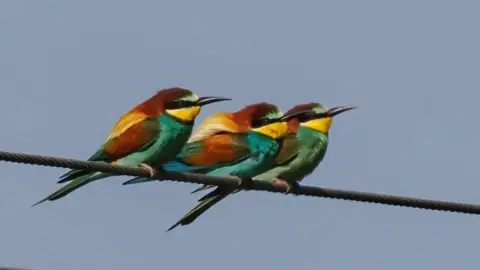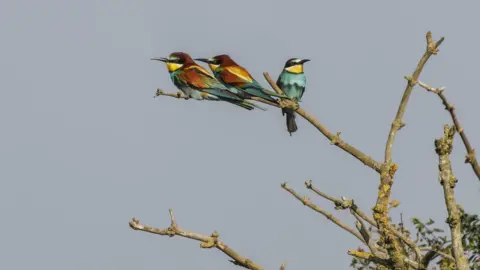Bee-eaters make historic return to breeding site in Norfolk
Three bee-eater birds are believed to have made a historic return to the UK.
A colony of breeding bee-eaters successfully hatched chicks in Norfolk last summer.
The RSPB said a trio of the colourful birds, including a nesting pair, had been spotted again in a sand quarry near Cromer.
It said it was the first time the summer visitors had returned to the same breeding site in the UK in consecutive years.
A public viewing area, managed by the RSPB, has been opened nearby for people wanting to see the birds.
Mark Thomas, from the charity, said it was a "real possibility" they were the same birds as last year, suggesting it could be the start of bee-eaters "properly colonising the UK".
But, he added: "Their return is a vivid reminder of the changes being wrought by our overheating planet.
"Bee-eaters are a species found commonly in the southern Mediterranean and northern Africa and as our planet warms they - along with other species - are being pushed further north."

 PA Media
PA MediaBee-eaters
- Bee-eaters are about the size of a starling and have claret-red backs, yellow throats and turquoise bellies
- They feed on various species of bees, dragonflies and other flying insects that they catch in mid-air
- There have been six recorded breeding attempts by bee-eaters in the UK in the past 20 years, with the last successful bid on the Isle of Wight in 2014
- The first bee-eater chicks to hatch in the UK since 1955 were in Bishop Middleham in County Durham in 2002
- In 1955, two pairs nested in a sand-pit in Sussex and raised seven young. Before that, the only other known nesting attempt was in Scotland in 1920
- Most recently, seven birds nested in Nottinghamshire in 2017, but the nests failed due to bad weather
Source: RSPB

Formerly very rare breeders in the UK, this year marks the seventh breeding attempt in England in the past 20 years, the bird charity said.
Eight Bee-eaters were a sensation when they arrived in Norfolk last June.
In June 2021, nine bee-eaters were spotted in land behind a retail park in Great Yarmouth.
 Mike Edgecombe
Mike Edgecombe Mike Edgecombe
Mike Edgecombe Mike Edgecombe
Mike EdgecombeThere are 27 different types of bee-eaters to be found, mostly in Asia and Africa.
The birds are known to migrate to southern Europe in late April through to early June.
The RSPB said bee-eaters, about the size of starlings, could be identified by their red backs, blue bellies and yellow throats.
As well as bees, they feed on dragonflies and other flying insects which they catch in mid-air.
With their beautiful rippling calls to match their vibrant colours, they are an "unmistakable visitor to have arrived in Norfolk", the charity said.
The birds are expected to remain in the area until the end of summer, after which they will fly to southern Africa for the winter.
The viewing area is open to the public, costing £5 per person to cover site monitoring and protection.

Follow East of England news on Facebook, Instagram and Twitter. Got a story? Email [email protected] or WhatsApp us on 0800 169 1830
